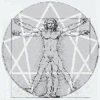“Seven cosmoses, taken together in their relation to one another, alone represent a complete picture of the universe. The idea of two analogous cosmoses, accidentally preserved from a great and complete teaching, is so incomplete that it can give no idea whatever of the analogy between man and the world. “The teaching on cosmoses examines seven cosmoses: “The first cosmos is the Protocosmos — the first cosmos. “The second cosmos is the Ayocosmos, the holy cosmos, or the MEGALOCOSMOS, the ‘great cosmos.’ “The third cosmos is the Macrocosmos — the ‘large cosmos.’ “The fourth cosmos is the Deuterocosmos — the ‘second cosmos.’ “The fifth cosmos is the Mesocosmos — the ‘middle cosmos.’ “The sixth cosmos is the Tritocosmos — the ‘third cosmos.’ “The seventh cosmos is the Microcosmos — the ‘small cosmos.’ “The Protocosmos is the Absolute in the ray of creation, or world 1. The Ayocosmos is world 3 (‘all worlds’ in the ray of creation). The Macro-cosmos is our starry world or the Milky Way (world 6 in the ray of creation). The Deuterocosmos is the sun, the solar system (world 12). The Mesocosmos is ‘all planets’ (world 24), or the earth as the representative of the planetary world. The Tritocosmos is man. The Microcosmos is the ‘atom.’ Fragments: Ten
“Beyond the sun, that is, beyond the solar system, he has not and cannot have any existence, or in other words, from the point of view of the next cosmos he does not exist at all. A man does not exist at all in the Macrocosmos. The Macrocosmos is the cosmos in which the possibilities of the Tritocosmos are realized and man can exist in the Macrocosmos only as an atom of the Tritocosmos. The possibilities of the earth are actualized in the MEGALOCOSMOS and the possibilities of the sun are actualized in the Protocosmos. Fragments: Ten

